For companies entering new global markets online, brand awareness is a mission-critical component for success. Even if local customers, partners and investors are aware of your brand, they are likely unfamiliar with specifics like:
- Your mission, vision and story
- Competitive positioning
- Corporate persona
- Product and programme names
- Slogans and taglines
Go Pro, or Go Home
Familiarising a new market with your brand often begins with launching a website in their preferred language. This requires translating web content-which can include text, images, apps, third-party feeds and more.
Website translation is more complicated than it looks, and can pose hidden risks to your brand accuracy and consistency. This usually arises when companies use local marketing, sales and engineering staff as translators.
They use these staffers because it’s easier, faster and cheaper than hiring professional translators.
Web localisation is riskier and more nuanced than it looks. Local marketers and engineers aren't ideal translators.
Cutting Corners
Local in-country managers, sales people, and IT staff are usually fluent in the local language, but they rarely possess professional translation experience. Their expertise is in other aspects of your business, not in marketing or branding.
Here’s what can happen when you use local staff as translators:
Off-Brand Messaging
Consistency across languages and channels depends on an adherence to a set of guidelines covering tone, voice and messaging. Non-professionals may be unfamiliar with brand guidelines, and could make word choices that stray from the style guidelines and damage brand integrity.
Style and Term Inconsistency
If different staff members get pulled into translation work, it's inevitable that their individual preferences, backgrounds and knowledge will lead to inconsistencies on the website. A mix of styles or terminology can affect brand uniformity and cause confusion for site visitors.
Goal Misalignment
Sales, marketing, IT and product specialists have their own goals in mind for the new market. They may alter the message of translated content through word choices or emphasis on what they think is most important. That means they're communicating goals that are different from those found on your flagship website.
Professional translation is the best choice for maintaining brand consistency and messaging. Although it is tempting to use existing staff, the potential risks to your brand image are not worth the initial cost savings-particularly in a new market where messaging missteps can be critical.
It's tempting to use existing staff as translators, but customers notice lousy localizations. The short-term savings aren't worth it.
Compromising the Experience
Just as amateur web translations can impact brand consistency, a partially-translated site can affect your brand image, too. Customers may feel you don't care enough about them to present a rich, fully localised experience.
Website translation requires technical fluency, not just linguistic fluency. Websites are highly complex experiences that load translatable content from numerous databases and third-party sources. Local managers who aren't familiar with the technical "nooks and crannies" of a website-or with SEO best practices-often overlook important content for translation, such as:
- Metadata
- Alt-tags for applications
- Text embedded in graphics
- Dynamically loaded third-party content
- Videos
Unless you use technical experts to identify these categories of web content, it’s likely that certain elements will be missed, leading to a compromised user experience.
Website translation demands technical fluency, too. Can your local staff locate and translate your site's unseen content?
Making the Best Impression
As the saying goes, you only get one time to make a good first impression. When you enter a new market, your brand and corporate reputation are on the line. You can't afford to put web translation quality, consistency or comprehensiveness at risk.
Choosing a technology-based solution featuring professional translation, such as a turn-key proxy, is a smart strategy. It avoids the pitfalls of using your local managers, who are skilled professionals in their own role, but are not trained or prepared to:
- Consistently apply branding principles and guidance
- Identify and translate hidden content elements and functionality
Both of these capabilities are essential to a satisfying, correctly branded web experience that can drive corporate growth and success in the new market.
Last updated on February 22, 2018
